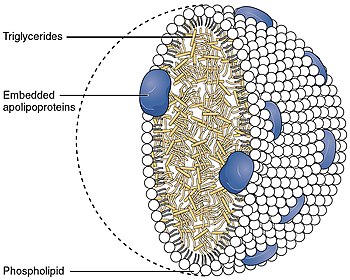High-density lipoprotein: Difference between revisions
Davidruben (talk | contribs) →References: switch to sub-cat |
No edit summary |
||
| Line 1: | Line 1: | ||
'''High-density lipoproteins''' ('''HDL''') form a class of [[lipoprotein]]s, varying somewhat in their size (8-11 nm in diameter) and contents, that carry [[cholesterol]] from the body's tissues to the [[liver]]. |
'''High-density lipoproteins''' ('''HDL''') form a class of [[lipoprotein]]s, varying somewhat in their size (8-11 [[nm]] in diameter) and contents, that carry [[cholesterol]] from the body's tissues to the [[liver]]. |
||
Because HDL can remove cholesterol from [[atheroma]] within arteries, and transport it back to the [[liver]] for excretion or re-utilization, they are seen as "good" lipoproteins. When measuring cholesterol, any contained in HDL particles serves as protection to the body's cardiovascular health. (In contrast to "bad" [[Low density lipoprotein|LDL]] cholesterol.) |
Because HDL can remove cholesterol from [[atheroma]] within arteries, and transport it back to the [[liver]] for excretion or re-utilization, they are seen as "good" lipoproteins. When measuring cholesterol, any contained in HDL particles serves as protection to the body's cardiovascular health. (In contrast to "bad" [[Low density lipoprotein|LDL]] cholesterol.) |
||
Revision as of 17:01, 10 July 2006
High-density lipoproteins (HDL) form a class of lipoproteins, varying somewhat in their size (8-11 nm in diameter) and contents, that carry cholesterol from the body's tissues to the liver.
Because HDL can remove cholesterol from atheroma within arteries, and transport it back to the liver for excretion or re-utilization, they are seen as "good" lipoproteins. When measuring cholesterol, any contained in HDL particles serves as protection to the body's cardiovascular health. (In contrast to "bad" LDL cholesterol.)
HDL are the smallest of the lipoproteins. They are the densest because they contain the highest proportion of protein. They contain the A class of apolipoproteins.[1] The liver synthesises these lipoproteins as complexes of apolipoproteins and phospholipid, which resemble cholesterol-free flattened spherical lipoprotein particles. They are capable of picking up cholesterol, carried internally, from cells they interact with. A plasma enzyme called lecithin-cholesterol acyltransferase (LCAT) converts the free cholesterol into cholesteryl ester (a more hydrophobic form of cholesterol) which is then sequestered into the core of the lipoprotein particle eventually making the newly synthesized HDL spherical. They increase in size as they circulate through the bloodstream and incorporate more cholesterol molecules into their structure. Thus it is the concentration of large HDL particles which more accurately reflects protective action, as opposed to the concentration of total HDL particles.[2] This ratio of large HDL to total HDL particles varies widely and is only measured by more sophisticated lipoprotein assays using either electrophoresis, the original method developed in the 1970s or newer NMR spectroscopy methods, developed in the 1990s.
Men tend to have noticeably lower HDL levels, with smaller size and lower cholesterol content, than women. Men also have an increased incidence of atherosclerotic heart disease.
Epidemiological studies have shown that high concentrations of HDL (over 60 mg/dL) have protective value against cardiovascular diseases (such as ischemic stroke and myocardial infarction). Low concentrations of HDL (below 40 mg/dL for men, below 50 mg/dL for women) are a positive risk factor for these atherosclerotic diseases.
HDL particles are not inherently protective. It is only the HDL particles which become the largest, i.e. are actually picking up and carrying cholesterol, which are protective. There is no reliable relationship between total HDL and large HDL, and more sophisticated analyses which actually measure large HDL, not just total, correlate much better with clinical outcomes.
In the stress response, serum amyloid A, which is one of the acute phase proteins and an apolipoprotein, is under the stimulation of cytokines (IL-1, IL-6) and cortisol produced in the liver and carried to the damaged tissue incorporated into HDL particles. At the inflammation site, it attracts and activates leukocytes. In chronic inflammations, its deposition in the tissues manifests itself as amyloidosis.
Recommended range
The American Heart Association, NIH and NCEP provides a set of guidelines for male fasting HDL levels and risk for heart disease.
| Level mg/dl | Level mmol/L | Interpretation |
| <40 | <1.03 | Low HDL cholesterol, heightened risk for heart disease, <50 is the value for women |
| 40-59 | 1.03-1.52 | Medium HDL level |
| >60 | >1.55 | High HDL level, optimal condition considered protective against heart disease |
More sophisticated laboratory methods measure not just the total HDL but also the range of HDL particles, typically divided into 5 groups by size, instead of just the total HDL concentration as listed above. The largest two groups (most functional) of HDL particles have the most protective effects. The two groups of smallest particles reflect HDL particles which are not actively transporting cholesterol, thus not protective.
Citations
- ^ Baylor College of Medicine, Lipids Online (January 29, 2001). "Heterogeneity of HDL". Retrieved February 20.
{{cite web}}: Check date values in:|accessdate=(help); Unknown parameter|accessyear=ignored (|access-date=suggested) (help)CS1 maint: year (link) - ^ Kwiterovich PO. The Metabolic Pathways of High-Density Lipoprotein, Low-Density Lipoprotein, and Triglycerides: A Current Review. Am J Cardiol 2000;86(suppl):5L.
See also
References
See also: cholesterol, low density lipoprotein

